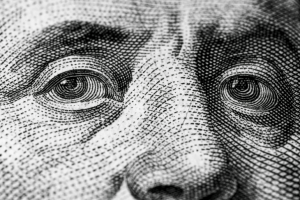Presidential Currency Fun Facts
Happy Presidents’ Day!
When asked about the criteria for appearing on U.S. currency, the Department of Treasury says that it has to be “persons whose places in history the American people know well.” The other criteria? It must not be the visage of any living person. With that in mind, it makes sense that our past presidents (and a couple of Founding Fathers) have made the cut and appear on our currency today!
Here’s some fun financial history in honor of Presidents’ Day!

Penny: Abraham Lincoln
The version of the penny that we know today was produced and issued in 1909, in celebration of the 100th anniversary of Lincoln’s birth. Up until the redesign of the quarter in 2022, President Lincoln’s was the only presidential portrait that faced to the right on a coin.
Nickel: Thomas Jefferson
The Jefferson nickel came about through a competition held by the U.S. Mint. A sculptor by the name of Felix Schlag won the competition and his design made it onto the new nickel, which began circulating in 1938.
Dime: Franklin D. Roosevelt
Designed shortly after his passing, Roosevelt’s dime was made to honor his part in founding and strongly supporting the March of Dimes, an organization that was founded to help children suffering from polio.
Quarter: George Washington
Also on the dollar bill, our first president has been on the quarter since the 200th anniversary of his birth, in 1932. At the time, only copper coins were marked with their worth. This meant that people had to know the size and weight of a silver dollar to know how much the smaller silver coins were worth. They knew that a silver dollar weighed four times as much as the quarter.
The quarter no longer contains actual silver like it once did – the innermost core is copper, encased in a copper and nickel mix.
Half Dollar Coin: John F. Kennedy
Jackie Kennedy herself chose the value of the coin that that U.S. Mint wanted to use to memorialize the president. The design is based off of his inaugural medal.
$1 Bill: George Washington
This is one of the oldest currency designs to still be in use today. George Washington’s face has graced the $1 bill since 1896, when paper money was still called “United States Notes.”
$2 Bill: Thomas Jefferson
Even older than the George Washington design, Thomas Jefferson has been on the $2 bill since 1862. Though it stopped printing in 1966, it returned to circulation in 1976 and is still printed today!
$5 Bill: Abraham Lincoln
Salmon P. Chase, who served as Lincoln’s Treasury Secretary, advocated for Lincoln to be on the $5 bill on the grounds of his leadership during the Civil War and his actions to preserve the Union. He saw it as a way to honor the president, but also as an uplifting reminder to the American people of the values of equality and freedom.
$10 Bill: Alexander Hamilton
Alexander Hamilton is one of the two non-presidents to be featured on U.S. paper currency. What makes him so special? In addition to being a Founding Father, he is our nation’s first Treasury Secretary.
In 2015, the government announced that a female figure would replace Hamilton as the face of the $10 bill. What stopped them? The popularity of the musical Hamilton!
$20 Bill: Andrew Jackson
Did you know that Andrew Jackson was in favor of abolishing paper money? So how did he end up on one of the most commonly used paper bills? It’s a mystery! There is no clear answer or accurate documentation that can attest to why his portrait was the one chosen to replace Grover Cleveland’s on the $20 bill.
$50 Bill: Ulysses S. Grant
Ulysses S. Grant, 18th President of the United States, has been on the $50 bill since it began circulation in 1913.
$100 Bill: Benjamin Franklin
The only other non-president to be featured on paper currency is Benjamin Franklin. This bill has the longest lifespan of all the U.S. paper notes, with an estimated circulation life of 15 years.
Did you know?
There are other bills no longer in circulation that displayed the face of other famous presidents?
$500 Bill: William McKinley
$1,000 Bill: Grover Cleveland
$5,000 Bill: James Madison
$100,000: Woodrow Wilson was the face of this gold certificate. Though it was never circulated, it was used to transfer money between banks during the Great Depression.